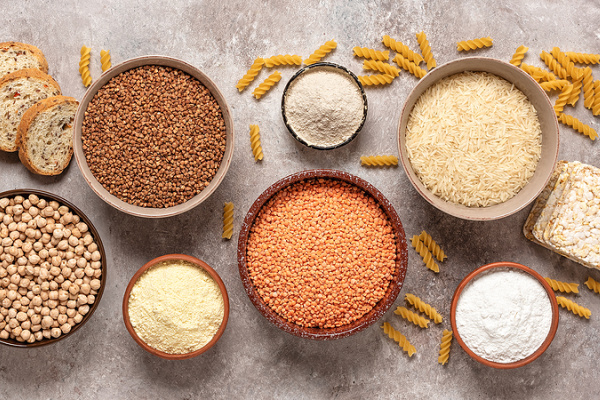
If you think you or your child may be allergic to wheat, this post is a great resource! We’re sharing common signs and symptoms to watch for as well as tips to help you determine if you’re dealing with a wheat allergy or celiac disease. We’ve also included a list of foods to avoid plus a link to a post with our favorite wheat free recipes for breakfast, lunch, dinner, and dessert!
What Are the Symptoms of a Wheat Allergy?
If you have a wheat allergy, your symptoms can come on within minutes of eating something with wheat, but sometimes the reaction won’t appear for a few hours.
Common symptoms of a wheat allergy include:
- Itchy rash, hives, and/or atopic dermatitis
- Itching, swelling and/or irritation of the mouth or throat
- Asthma and/or difficulty breathing
- Anaphylaxis*
- Headache
- Nasal congestion
- Itchy/Watery eyes
- Cramping and bloating of the stomach
- Nausea and/or vomitting
- Diarrhea
*If signs of anaphylaxis are present, but sure to seek IMMEDIATE medical attention.
What Causes a Wheat Allergy?
Wheat contains 4 different wheat proteins:
- albumin
- globulin
- gliadin
- gluten
If someone has an allergy to one or more of these proteins, their immune system mistakes the protein(s) as a pathogen and attacks it, causing one or more of the symptoms listed above.
Children are more susceptible to developing a wheat allergy as their immune and digestive systems aren’t fully developed, but many outgrow their allergy as they get older.
Family history also plays a role in the development of a wheat allergy. If a close family member is allergic to wheat, it increases the likelihood that other people within the family will develop a wheat allergy as well.
Some people only develop wheat allergy symptoms if they exercise within a few hours of consuming wheat, while others develop a condition known as ‘baker’s asthma’ which causes breathing issues when they inhale wheat flour.
How is a Wheat Allergy Diagnosed?
- Elimination diet. If you suspect you have a wheat allergy, a great first step is to commit to an elimination diet. This involves completely removing wheat from your diet for a period of time, and then reintroducing it to evaluate how your body reacts.
- Food challenge test. If your symptoms are more severe, you may need to participate in a supervised food challenge test at your allergists’s office or in a hospital. This involves swallowing capsules of allergens while an allergist/doctor monitors how your body reacts.
- Skin test. A skin test involves placing liquid drops of diluted allergens onto your skin, piercing the skin through the drop, and waiting to see how your skin reacts. Skin tests aren’t definitive, so if swelling, itching, and/or hives develop, you will likely be sent for further testing to confirm if you have an allergy.
- Blood test. A blood test will detect antibodies to any foods you are allergic to.
Is a Wheat Allergy the Same as Celiac Disease?
No. While the symptoms are similar, there are some key differences between the two. A wheat allergy is a temporary immune reaction to one or more wheat proteins, whereas celiac disease causes damage to the lining of the small intestines over time, resulting in diarrhea, bloating, weight loss, fatigue, and anemia. Untreated celiac disease can also prevent the small intestine from absorbing nutrients, which can interfere with growth and development in children and lead to other health challenges in adults. Many people overcome wheat allergies as they get older, while celiac disease is a chronic autoimmune disorder.
11 Foods to Eat and Avoid with a Wheat Allergy
It’s important to note that not all gluten-free foods are wheat-free, and not all wheat-free products are gluten-free, which can make things tricky.
If you have a wheat allergy, here are 11 types of foods to avoid.
- All foods containing wheat and wheat proteins. While barley, oats, and rye are considered wheat-free, they can contain wheat proteins so read labels carefully
- All foods containing gluten
- Breads, crackers, wraps, cereals, pastas, and baked goods, unless the label specifically states the product is wheat-free and no wheat proteins are listed in the ingredients
- Snack foods like granola, cereal, and energy bars, chips and pretzels, candy bars and snack mixes often contain wheat and wheat proteins
- Condiments like soy sauce, barbecue sauce, ketchup, marinades, spices, and certain salad dressings can contain wheat and wheat proteins
- Ice cream and ice cream cones
- Processed meats like hot dogs as well as meat, crab, and shrimp substitutes
- Beverage mixes like coffee substitutes, chocolate milk mixes, and drink mixes
- Beer, ales, and root beer
- Gum
- Other items including modified food starch, gelatinized starch, hydrolyzed vegetable protein, natural flavourings, and monosodium glutamate
*This is not a complete list of foods to avoid with a wheat allergy
**Be sure to check labels to confirm wheat proteins are not present in the foods you are confirming, and to ensure the foods you are buying have been processed in a wheat-free facility
If you are looking for wheat free diet recipes to try, THIS POST has tons of delicious ideas the whole family will love!
If you or your child has a wheat allergy, I hope the information in this post proves useful to you!


